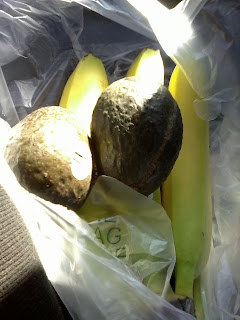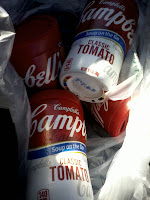 |
| $2.25 for 3 lbs of apples. |
In the summer it's so easy. We picked quart after quart of mulberries, gallon after gallon of apples. We had rhubarb anytime we wanted it. Squash came out of the woodwork from everyone, so did peppers. We had gobs of tomatoes and carrots from the garden. I never had to think about it. But by about November, all of those were used up or frozen.
So I hopped to it and started adding them back to our diet. In doing so, I brainstormed the ways in which I save money doing this as it could get expensive if you're not paying attention.
1) Shop at an Aldi's, Save-A-Lot or similar discount store.
I shopped Save-A-Lot in Florida and Aldi here in Kansas. They, by far, have the absolute, lowest, best prices on produce I have ever seen. I regularly get avocados for 25-29cents each at Aldi. Just this week I got a 3-pack of bell peppers - one green, one red, one yellow - for $1.29. A 3-lb bag of sweet potatoes is always 99 cents.
I've gotten baby carrots 49 cents a pound, broccoli 99 cents a bunch. Their bananas are always 39 cents a pound. If you have one of these near you, check it out as their regular prices will likely be lower than anywhere else and their sales are phenomenal.
 |
| 50 cents per avocado & 39 cents a lb bananas. |
2) Shop the sales.
As I said, Aldi and Save-A-Lot's sales are tremendous, so be sure to get their ads either from in-store, from the paper or online.
However, other stores do have competitive prices when things are on sale. Every single I week I get four sales fliers - two local grocery stores, Dillons and Aldi - and see what's on a great sale and then I stock up.
I ran out of my 25-cent avocados but our local grocery store had them on sale for 50 cents, still half off what Dillons or Walmart charges.
These bananas were 39 cents per pound there as well.
3) Buy generic, small quantities of fresh and larger containers instead of individual cups.

 I want Brady to have a healthy lunch and I pack it every day (mostly due to his egg allergy). I work full-time so I have to spend a little extra for convenience.
I want Brady to have a healthy lunch and I pack it every day (mostly due to his egg allergy). I work full-time so I have to spend a little extra for convenience. 
 But that doesn't mean it has to be super expensive. Brady loves pears, mandarins and green peppers. The Walmart brand pears and mandarins are about $1 per can and I can make them last for 3 days each.
But that doesn't mean it has to be super expensive. Brady loves pears, mandarins and green peppers. The Walmart brand pears and mandarins are about $1 per can and I can make them last for 3 days each.The peppers are 50 cents a piece at Walmart if not on sale. I'll buy two and give him a half of one at each serving, getting four servings out of them. When I get grapes, I take a small bunch out of the larger bag so as to not get more than 1 pound.
I also get unsweetened applesauce, so instead of buying the individual cups, I will buy the jar and then put some in a small container for his lunch.
4) Buy in season.
If you shop the sales, you are likely to get a good sense of what's in season. For example, it was lucky we had SO MANY apples because they were not on sale for a very long time. Just about the time I used the last bit from our freezer the other day, Aldi finally had them on sale again.
In the summer, there are times you can get a whole cantaloupe for 99 cents. When strawberries are in season, I have gotten them for 99 cents a carton. This way you're also getting a variety of produce throughout the year.
5) Grow your own.
 I used to think this wasn't possible in the city, but now I know it is. For one, lots of cities have community gardens that you can either tend your own plot or buy from. You can find out if one is nearby you at this website.
I used to think this wasn't possible in the city, but now I know it is. For one, lots of cities have community gardens that you can either tend your own plot or buy from. You can find out if one is nearby you at this website.One community garden at a church here in Kansas had a "public" section where anyone could take a few tomatoes when they wanted. In Florida, I once gathered fresh rosemary from a bush in a garden club garden. It's worth taking the time to see what is in your community.
 Next, my mother lived in a very small apartment in California for years and still managed to grow tomatoes and peppers in little pots on her balcony.
Next, my mother lived in a very small apartment in California for years and still managed to grow tomatoes and peppers in little pots on her balcony.Fruit trees are an amazing investment. They may take some time, but I have partaken of fresh lemons and grapefruits in Florida, and fresh apples, peaches, pears and mulberries here in Kansas. They will give and give and give each year.
And of course, if you have a little space in your yard to grow your own, it is a fantastic adventure on many levels, for adults and kids alike.
6) Don't forget about canned and frozen, and use coupons.
 |
| $1 a piece, 50 cents less than Walmart |
Around the holidays you can get canned corn, green beans and peas for 50 cents a can or less. Sometimes diced tomatoes go on sale for 50 cents and I stock up. Aldi had tomato soup for 49 cents a can, and these Soup-At-Hands are normally $1.50 at Walmart but I got them for $1 a piece at our local grocery store. They are a perfect easy and healthy addition to Brady's school lunch.
Just recently I had some manufacturer's coupons for the soup-at-hands. I'd already used them but that would have made an even better sale! There are often coupons for major brands, both canned and frozen. Pair them with a sale and you can stock up on lots of good veggies and fruits.
7) Pick your own.
Many communities have pick your own farms for fruits and vegetables. I personally picked blueberries in South Carolina and pumpkins here in Kansas. But I've seen them for other berries, veggies and apples. You can see which ones are nearest you at this site.
They are typically a good deal lower in price per pound than the store. This is also a great experience for kids, helping them understand where food comes from.
8) Shop a farmer's market.
Farmer's markets offer local fresh produce at prices better than you'll typically find in a store. You'll also likely find a wider variety of types of produce. Here is a site where you can locate ones in your area.
9) Freeze, freeze, freeze!

As I said in my post on freezing everything, this is one huge way you can make sure you always have easily accessible fruits and veggies around even when none are on sale and also save money in the process.
 I just made applesauce yesterday from apples we picked this summer that I cut and froze. When garden veggies are so plentiful they're taking over your kitchen, cut or shred and freeze them. That's what I used to make zucchini coins the other night as well and I just thawed out a batch of homemade salsa (photo at left) this week.
I just made applesauce yesterday from apples we picked this summer that I cut and froze. When garden veggies are so plentiful they're taking over your kitchen, cut or shred and freeze them. That's what I used to make zucchini coins the other night as well and I just thawed out a batch of homemade salsa (photo at left) this week. If you get a good sale on produce, stock up, cut it up and freeze it. Same with pick your own. When I did that with blueberries, I froze a bunch of them for later use.
10) Share with family & friends, and perhaps get some in return.

 When either my mom or I get a lot of stuff on sale, we usually share some with each other. When we cook a big meal, we usually freeze some for the other. When I picked a bunch of apples, I'd share some with my in-laws, and in turn they have shared much from their garden.
When either my mom or I get a lot of stuff on sale, we usually share some with each other. When we cook a big meal, we usually freeze some for the other. When I picked a bunch of apples, I'd share some with my in-laws, and in turn they have shared much from their garden.The more you give, the more comes back to you in return, I think. Getting in return shouldn't be your motivation, but it seems to me that's how it usually works out. Generosity breeds generosity.
And if you have a relative or friend that cans, like my sister-in-law who gave us this glorious batch of canned salsa, relishes, apple butter etc. for Christmas, all I can say is get in good with those guys! Wow, that is some of the best salsa I've ever eaten! :)









No comments:
Post a Comment
I truly enjoy your comments and love to interact. Be sure to check the "notify me" box below to see new comments and replies to your comment! Thank you!